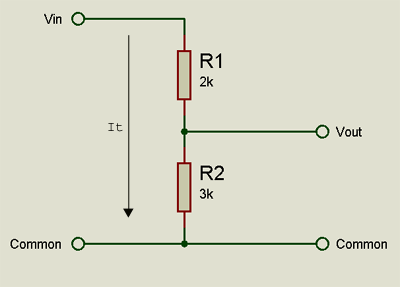The potential divider
In a previous article, the potential divider was shown that takes a voltage in and scales it down to another voltage out. The "magic" formula for this scaling was given as Vout = Vin * (R2/R2 + R1)
Well, there's nothing magical about this at all, it's basic physics and some simple math.
Let's look at the circuit diagram for the potential divider again. However, added this time is an arrow that represents the current (in amps) that flows through the circuit.

From Ohm's Law this current flow can be calculated. So, in the example shown, if Vin was 10v then the current flowing through the circuit is 10 / (R1 + R2) or 10 / (2000 + 3000) which is It = 0.002A (or 2milliamps).
Now, to calculate Vout, we can simply use Ohm's Law again. The current flowing through R2 is the same current flowing through the entire circuit, 0.002A.
So the voltage across R2 is R2 * It (or 3000 * 0.002) which is 6v (assuming Vin is 10v).
So we have 6v. But where does the "magic" R2 / R2 + R1 come from?
Well, It = Vin / (R1 + R2) so we can re-write
- Vout = R2 * It
as
- Vout = R2 * (Vin / R1 + R2)
Simple algebra allows us to rewrite this as
- Vout = Vin * (R2 / R1 + R2)
So Vout is 6volts.
Let's check this with the "magic formula"
Vout = Vin * (R2 / R2 + R1)
Vout = 10 * (3000 / 3000 + 2000)
Vout = 6v
2 comments on The potential divider:
Please log in to post comments.



I think the formula should be like this. Order of operations is incorrect and won't calculate properly. Let me know if I'm wrong here, maybe I'm just not very good at math.
Vout = Vin * (R2 / (R1 + R2))